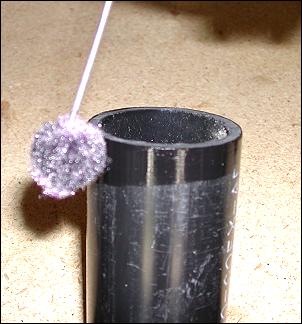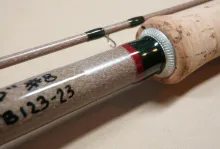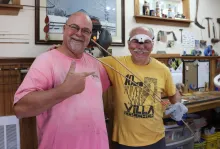You have one extra rod with no sock and rod tube. You've been putting off buying a tube...why don't you just make your own?! With $4.00 and about a 1/2 hour's time, you'll have a DIY rod tube. These won't win beauty contests, but they work just as well as any retail version. Read here how to DIY.
DIY Rod Tubes
They're not pretty, but they sure do work!
From time-to-time, somewhere down the line, you'll need a rod tube because of that one rogue rod without a sock and without a tube. But you've stalled on buying a rod tube becuase they are so darned expensive. The solution is to make your own! In under a half hour, you can fabricate a dozen or so tubes if you need that many. It's that easy!
And the price is right too.
The materials
The materials required are minimal and the investment is small. You'll need:
- A china marker
- A rag
- A fine-toothed, small kerfed pipe or hand saw
- PVC Primer and Cement
- PVC piping, schedule 40 works fine
- 1 closed endcap
- 1 open female-threaded endcap
- 1 male-threaded end plug
A simple cost breakdown reveals an appealing price to this Do-It-Yourself project. For a 3-foot rod tube, my costs were:
- PVC pipe: $0.238 per foot: $0.71
- 3'x1' flannel cloth for rod sock: $0.25
- Closed end cap: $1.49
- Threaded end cap: $0.98
- Threaded end plug: $0.57
- glue and tools: negligable cost
TOTAL COST FOR A 3-FOOT TUBE and sock cloth: $4.00

The upfront material costs are minimal, and the material itself is easy to find. (L to R middle row: open female-threaded endcap, male-threaded end plug, closed endcap.
Getting started
Lay the PVC on a flat surface and measure your rod(s) against the PVC. Mark the cut point with a china marker. You can cut the PVC to the exact length of the rod as the end cap and threaded cap add about a 1/2" to the length, giving you an extra inch to play with.
After the PVC sections are cut to length, line them up and arrange all the required end pieces behind the tube in the order in which you will assemble: closed end cap, then the threaded end cap. You'll be glad you organized the parts because PVC cement dries very quickly, leaving you little time to shuffle around looking for the parts.

Lay out the pre-cut PVC and all parts prior to assembling. Be sure to work in a well ventilated areas such as a garage, as shown here.
Priming and cementing
Prior to assembling the parts, wipe them with a damp cloth to remove dust and shipping debris. This will aide in the priming and glueing steps. Also, be considerate of yourself and perform this step in a well ventilated area such as the back patio or your garage.
All PVC needs some priming to 'scuff' up the surface. This is done with a chemical PVC primer. Be careful as PVC primer will most assuredly drip where you don't want it...it stains and it is sticky. Pre-fit the pieces to get a feel where the PVC contact points are. Then prime just those areas on each PVC tube. BE sure to prime the tube and the inside of each fitting.
Apply the cement in the same fashion, coating both the PVC tube and the inside of the fitting with ample cement. Quickly assemble the fitting on the PVC tube and twist to ensure full coverage of the cement to all the glued surfaces. In just a few moments, the cement will set.

Be very careful with PVC primer...its runny and stains almost everything.
Once the tubes are assembled and glued, allow them an hour or so of curing time in a well ventilated area. It's not advisable to stick your rod in the newly glued tube...there just may be some cement that hasn't dried thoroughly.

Making a few rod tubes can be done in under a half an hour and required no special tools.
The finishing touches
Although the picture to the right doesn't clearly show the markings, use a metallic permanent pen to label your rod tube with the contents.
Rod socks can be purchased from most any rod making supplier for around $5 to $10, depending on the material you choose. Or, to carry the theme of this article, make your own rod sock to your exact specifications.
Me personally, I like just a sheet of flannel the length of my rod and the width of a foot or so. I begin rolling in each rod segment in one at a time, like a wrapping a cigar. No stitching is required and the cost of the flannel is minimal at best.
Then, insert the rod-in-sock, tighten the cap and go to the stream in confidence that your rod is safely protected!
I actually needed a few rod tubes to mail some rods I had sold. After trying to find appropriate cardboard tubes of varying lengths, I decided to cost out making my own. In the end analysis, the cardboard tubes cost the same and in some cases more expensive for longer sections I needed. I then decided to make my own.
These DIY rod tubes aren't going to win any beauty or crafstmanship awards, but with just a sheet of flannel and some PVC they are just as functional as any on the market...at 1/10th the price.

Mark your rod tube of the contents with a permanent ink marker.
- Log in to post comments








A gun sock that ties
A gun sock that ties works well to hold a couple of tubes for travel
Thanks. I've been t
Thanks. I've been thinking about this for a long time, but didn't think I'd be able to do it, and really didn't know how to go about it. :)
Hi Rudi
These are a
Hi Rudi
These are available here at Home Depot stores. The three I made three years ago I'm still using. If you're still in the market let me know how many you want and I'll make arrangements.
Hi
I live in Isra
Hi
I live in Israel, I doubt I can find the:
- closed endcap
- open female-threaded endcap
- male-threaded end plug
Is someone willing to ship to me a few peaces? I will pay all expenses + a nice fee for your time.
Just reply here or pm if that is possible.
Thanks!
Sandy,
I don't kn
Sandy,
I don't know whether they would be the best, but they would be fairly inexpensive, certainly better than no tube and you could make them exactly the length and diameter you wanted.
Depending on the thickness material you choose for your tubes they could become a very good protection for your rods. Check out the options in your local plumbing supplies store. Plastic pipes for sink drains seem to be available in the proper diameters. They usually come in many lengths and can be fitted with plugs and end caps.
Martin
Hi, have a question
Hi, have a question about the rod tubes. I have some expensive rods and was wanting to make some rod tubes for them. They are 1 piece rods, 5'4 up to 7'10 and they are spinning rods. I'll probably have to have 2 1/2 in. pipe. I was wondering if these rod tubes would be the best for my rods and any ideas or suggestions. Thanks alot.
I was thinking of bu
I was thinking of building some rod case's and you gave me the boost I needed
I have made these fo
I have made these for a while as well. One touch that I add is after I get the pieces assembled, I will lightly sand the parts, and clean them well. Then I will spray the tube with a can of spray-on bedliner bought from AdvanceAuto. I will do a few coats, and increase my distance from the tube on the 2nd or 3rd coat to add more texture. It creates a very tough finish and has lasted me quite a while.
If you'd like a more
If you'd like a more attractive or unique case, there are two things I've done that others may find fun to try. Both options increase the cost slightly. First, you can purchase cordura fabric, factory seconds or closeouts, for ~$6.50 a yard (check ebay for example). Your case will look professional if you do this. This is exactly how the good cases are made. Simply glue the cordura to your pipe, or stitch a tube and slide the pipe in. You can even add webbing for a handle or sling.
Second, and the most fun IMO, is to purchase white pvc, not abs. Using a medium grain sandpaper, sand the length of tube. Get the entire surface sanded. Then, using a rough grain sandpaper (medium will also work) run the sand paper from top to bottom (once or twice only - do not sand back and forth for this step). Force the grit to slice vertical lines down the pipe. Different techniques will give you different effects, you'll have to experiment. Now for the trick - take your favorite color of wood stain, and stain the pipe. Run your clothsponge with the stain from the top of the tube to the bottom. You will notice immediately that your case is taking on an uncanny wood appearance. Some folks can't tell it's pvc even when holding the case. Using a small camp stove and leather gloves, you can kinkbendwarptwist the pipe to increase the wood effect before you sand and stain. Beware of fumes.
I've been making didgeridoo instruments this way for over a decade. Each one is unique, and I've never had anyone guess it was pvc.
Tracy,
They can b
Tracy,
They can be checked in, and will do nicely and be sturdy enough for air travel. But don't expect to bring them as hand luggage - or anything like them. Those days are over. Security is much too tight to let anything like a rod tube go through these days.
Martin
Can these types of r
Can these types of rod cases be taken on airlines?
I just used ordinary
I just used ordinary contact cement to attach the PVC fittings. Buying the actual primer and cement would have added another $5-6.00 dollars to the two tubes I built. I was able to get the contact cement at a local dollar store. It's been two years and no problems.
Hi Steven
Great ide
Hi Steven
Great idea. Thank you! Did you use 1 1/2" or 2" PVC?
Gene Mahn
Pvc is wonderful stu
Pvc is wonderful stuff, man. The (dubmon1)
You guys are always
You guys are always thinkin, man. Your fly patterns are some of the very best I have ever tied/used. when I need some help with anything to do with or about fly fishing, I come here. Thank you very much people. the (dubmon)
I had two rods that
I had two rods that had their gloss finish bubble completely off from storing a rod in a PVC rod tube that was homemade. I was able to scotchbrite the failed finish off, and refinish the rods. Since then, I know there have been changes made in PVC formulations, so I don't know if this may happen with some rods or not. Also, I can't speak for black ABS, but I thought it was worth mentioning.
I've made several of
I've made several of these over the years, the last for a 2 piece 9 1/2 foot 8 wt that was going in baggage when I flew back east. I went with an end cap I found in the hardware store that screws in flush with the end of the tube. It has an indented cross, like a huge phillips head screw, that requires a tool to open. I felt this would dicourage the merely curious from getting into it in transit. I also like to add a handle and shoulder strap that I pop rivet in place-but ALWAYS use a rod sock as the end of the rivet on the inside of the tube can scratch the rod.
What store do you bu
What store do you buy your PVC tubing from? I went to a local LOWE'S and HOME DEPOT but they only carried the thick walled super heavy big tubes? I like in Detroit, MI.
Any suggestion would be nice ASAP. Thanks!
Another great produc
Another great product for making rod tubes is central vac tubing available at any large building supply outlet like Home Depot etc. There are even snug fitting end caps available to seal up the ends. What I do is cut the pipe to length, wet sand it with about 600 or 800 grit to make it shiny and slick. Glue the end cap in place for the bottom (put some closed cell foam in the bottom of the cap for rod protection) I then drill a small hole in the top cap (perfectly centered) and another in the side of the tube. These are done to connect the top cap to the tube with a piece of small diameter rope. Central vac tubing is made up of the same material as the PVC mentioned above (at least I think it is) but it has thinner side walls. It's still very durable however. I have found it in white and grey colors. It's pretty cheap as well. A 12ft length cost me about $10.00 and the matching end caps were $0.50 a piece.
If I'm not mistaken,
If I'm not mistaken, that's ABS pipe, which is chemically different from PVC, and has its own specific primer.
Using PVC cement will help make a mechanical joint between two pieces of ABS, but if you want a permanent joint (one that won't come apart when subject to baggage handling abuse), you may want to use the primer and cement that's specifically made for ABS.
The pictures indicat
The pictures indicate tubes of ABS not PVC. Is this correct?
I made one of these rod Tubes For my Three Piece Fly Rod.
I made one of these rod Tubes For my Three Piece Fly Rod.I'm not paying a big price for a ROD TUBE? when there so easy to make